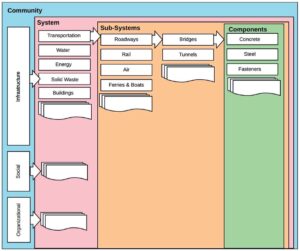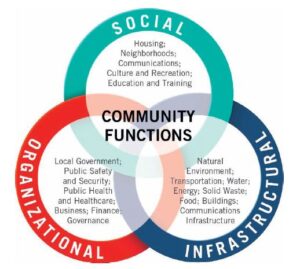
The ecosystem of resilience standards
Introduction
![]() Over the past few years, the term “resilience” has entered the national lexicon. Hurricanes, wildfires, tornadoes, flooding, and now the coronavirus disease 2019 (COVID-19) have expanded the nation’s understanding of what it means to be vulnerable and at risk of hazards posed by natural events, man-made threats, and disease outbreaks. The concept of resilience captures the notion that there are actions that can be taken in advance of such events to lessen the impacts and keep economies working.
Over the past few years, the term “resilience” has entered the national lexicon. Hurricanes, wildfires, tornadoes, flooding, and now the coronavirus disease 2019 (COVID-19) have expanded the nation’s understanding of what it means to be vulnerable and at risk of hazards posed by natural events, man-made threats, and disease outbreaks. The concept of resilience captures the notion that there are actions that can be taken in advance of such events to lessen the impacts and keep economies working.
Resilience theory can be traced back to Holling’s 1973 work, “Resilience and Stability of Ecological Systems,” in which he described resilience as the ability of an ecological system to continue functioning when changed (Holling 1973). Resilience has also been used to describe similar concepts in mental health, engineering, and now, communities. The National Academies of Sciences, Engineering, and Medicine (NASEM) defined resilience in the context of disasters as “the ability to prepare and plan for, absorb, recover from, or more successfully adapt to actual or potential adverse events” (NASEM 2012).
As outlined in this paper, resilience-building activities require a holistic and coordinated approach that operates at multiple scales, integrating the desired performance objectives for a whole community all the way through materials and components. Standards, codes, and conformity assessment activities are fundamental to assuring that such a system works. Within many of these levels, a robust collection of standards already exists. These standards cover multiple topics and were probably not developed with the concept of resilience in mind, but they do support efforts to achieve resilience.
Collectively, these standards make up a resilience standards ecosystem. Figure 1 captures a graphical representation of the resilience standards ecosystem where each higher level encapsulates and relies on the content of the prior level. A weakness at any level can impact the resilience of the level above it. A community is only as resilient as its weakest link.

As standards development organizations (SDOs) develop new or update existing standards, it is important to recognize how the standards fit within this ecosystem and where they intersect with the standards at the levels above and below them. It is important to understand what performance levels users along the entire continuum desire and how the SDO standards help them achieve those performance requirements. It is also important to explicitly identify and consider how each specific standard supports resilience to assist resilience practitioners in effectively using standards. Resilience requires an interdisciplinary effort that aligns goals and strategies.
Community resilience
As communities set their expectations for the level of acceptable impacts from certain adverse events and their ability to recover from such events, they need to point to metrics and standards to communicate their expectations and measure whether they are being met. The Alliance for National & Community Resilience (ANCR) is developing a system of Community Resilience Benchmarks (CRBs) that provide communities with metrics to support consistent evaluation of their resilience across community systems. ANCR has identified nineteen community functions that influence the resilience of a community, while, at the same time, define what makes a community a desirable place to live and work. These functions, shown in Figure 2, represent social, organizational, and infrastructural aspects of communities.

ANCR is in the process of developing benchmarks for each of these nineteen community functions. To the greatest extent practical, the benchmarks will utilize existing standards to serve either as the basis for a particular requirement or as acceptable evidence of achievement of a requirement. Thus far, ANCR has developed benchmarks for buildings and housing and is in the process of developing the Water Benchmark (ANCR 2019a, ANCR 2019b). Details on the content of the Buildings Benchmark are provided in the Systems Resilience section.
In many cases, the policies and requirements for systems are established by governments at the community level—based on standards or other guidance. For example, communities adopt and enforce building codes to capture community expectations on the minimum performance of buildings in their jurisdiction. Public utility commissions set requirements for energy and water infrastructure. School boards and education departments establish criteria for educational facilities and learning outcomes.
System resilience
Communities are made up of such multiple systems. These systems must function in harmony to provide resilience. Communities are a high-level system under the system-of-systems approach that many scientists have come to embrace. As each system is identified, there is another system within it that feeds an ever-growing complex system above it. Looking at a community through a resilience lens, this system-of-systems approach helps explain the importance of addressing resilience at multiple scales. The nineteen community functions identified by ANCR provide a good starting point for such an examination.
Each community function is a system in itself—with a workforce and standards of its own. These standards should be coordinated within these systems. Looking at the design, construction, operation, and regulation of buildings, a complex system is already in place. Architects, engineers, general contractors, specialty contractors (electrical, plumbing, masonry, carpentry, etc.), facility managers, code officials, product manufacturers, and other professions are all essential to the success of the building sector. The sector also intersects with the finance and insurance sector, which funds and insures buildings. Buildings are also an enabler for so many other sectors. Businesses rely on buildings to house their operations. Health care is provided in hospitals and clinics. Education happens in schools. Public safety requires police and fire stations, prisons, and courthouses.
Given the important role of buildings, ANCR decided to focus on the resilience of the building sector as its first benchmark. The subject matter experts charged with development of the ANCR Buildings Benchmark focused on the metrics that define the building sector (ANCR 2019a). Fundamental to the resilience of the building sector is the adoption and enforcement of building codes. Building codes themselves follow a system-of-systems approach, integrating standards that cover multiple building systems and components into a document capturing the minimum acceptable level of performance of a building. Building codes include standards focused on a building’s structural system from organizations such as the American Society of Civil Engineers (ASCE); mechanical, electrical, and plumbing systems from organizations such as the National Electrical Manufacturers Association (NEMA), National Fire Protection Association (NFPA), and NSF International; and They also point to standards that govern the properties of materials used in buildings, including wood, masonry, gypsum, steel, concrete, glass, and others.
In addition to codes, the Buildings Benchmark looks to other important characteristics of the building sector—the education and training of contractors (ideally based on credentialing programs); the identification and mitigation of vulnerable buildings and critical facilities (using standards and codes as the basis for evaluation and the desired levels of improvement); and the availability of incentive programs to encourage building owners to go beyond minimum requirements (again relying on standards to verify achievement of incentive program requirements). Each of these characteristics can be traced back in some way to a standard or conformity assessment program.
Within each of the community functions, there is an equally complex system of standards and criteria. ANCR is now undertaking development of the Water Benchmark, which relies on pipes from ASTM International. All these standards are important to the overall resilience of the water system and ultimately the community as a whole.
Component or material resilience
The first resilience standards were focused on materials and components—although they were not specifically developed as such. The durability of materials and the expected performance levels of products and materials directly influence the resilience of a system. For example, within the transportation system, a bridge’s ability to remain operational over time is predicated on the durability and characteristics of the concrete and steel used to support its loads. ASTM and groups like the American Concrete Institute (ACI) and the American Iron and Steel Institute (AISI) produce standards focused on material characteristics, test methods, and their appropriate uses (ASTM 2020a, ASTM 2020b, ACI 2020, AISI 2020).
Many of these individual material standards are referenced by standards that cover a collection of parts and pieces to make up system components. For example, a communications system is made up of hardware components, like switches and routers, which rely on the performance of the individual parts that are contained within it. These switches and routers have their own performance criteria and standards.
The individual standards for materials and components are encompassed by larger and larger bundles until they reach the level of an entire system. Vulnerabilities within any component in the system can lead to a cascading failure that impacts the resilience of the entire system, and thus, the community that relies on it. If one component of the system breaks, the resilience of the entire system is in jeopardy.
Other important resilience elements
While resilience-related standards are essential, there are other important elements that support resilience, such as conformity assessment mechanisms and a resilience workforce.
As noted above, a community, system, or component is only as resilient as its weakest link. Conformity assessment can help assure that those potential weak links are identified, and an appropriate action is taken to bolster them. Product testing and certification can help assure that materials and products meet durability requirements and are fit for the purpose. Accreditation for system owners and operators can assure that resilience remains a top priority in both long-term planning and day-to-day operations.
Since resilience is a new concept and way of thinking for consumers and communities, many do not know how to differentiate highly effective products and services from low-quality items that may not meet their needs. Certification and accreditation can be important tools for verifying the expected level of performance. They can also help set a minimum level of performance for new entrants into the field.
In addition to conformity assessment of products and services, development of a strong cadre of resilience professionals is needed. To date, practitioners in the resilience field have come from a variety of backgrounds and with a variety of experience levels. While this diversity of disciplines is essential for implementing a multipronged resilience strategy, a consistent underlying knowledge base is important. Certificate and certification programs will be necessary to build this knowledge base and professionalize the resilience workforce.
These certificates and certifications will likely focus on multiple aspects of the resilience ecosystem but should have a common core built on the standards and criteria discussed in this paper. University and vocational degree offerings can be built around these core criteria to assure that there is a cadre of resilience professionals moving into the future. Resilience concepts should also be incorporated into other degree offerings that influence the ability to achieve community resilience, including business, architecture, engineering, public administration, political science, and public health.
Furthering the resilience ecosystem
Achieving resilience is not a process that occurs once. Risks are always evolving. When a community or system attends to one challenge, there is often another one emerging that must be addressed. SDOs and conformity assessment bodies will need to continually update their products to address changing risks and support new solutions.
Climate change is a perfect example of the need to adapt. Codes and standards are typically predicated on the desire for certainty—follow these procedures and you will achieve the specified result. However, climate change is altering the risks we have used to develop codes and standards. Disaster events or risks of the past have been a pretty good predictor of the types of risks we would face into the future. This is no longer the case. Climate scientists tell us to expect more frequent or more intense storms or prolonged heat waves or cold snaps, but they cannot tell us exactly when or where such changes will occur. Some of this uncertainty is because the emissions of greenhouse gases over time are based on political and social choices, and therefore highly unpredictable. Further, it is difficult to downscale climate models to impacts at the project scale—the very scale many codes and standards are designed to influence.
A few SDOs are beginning to tackle these challenges. ASCE has been active in many of its committees and councils, developing strategies to adapt both the design process itself and the standards that engineers rely on (Ayyub 2018, ASCE 2015). The International Code Council (ICC) has engaged code development bodies from Canada, Australia, and New Zealand in a joint initiative to identify strategies and research needs to capture climate-related risk into codes and standards (ICC 2019). This initiative will also inform efforts to engage US-based stakeholders in formulating approaches to assure that buildings and other pieces of infrastructure remain resilient across their life cycle.
Conclusion
Achieving resilience is a challenge that will face communities; infrastructure; economic and social systems; and component and material manufacturers for years to come. A robust, coordinated ecosystem of standards, codes, and conformity assessment programs is necessary to support the cost-effective and efficient realization of resilience goals. As the recent COVID-19 pandemic made clear, communities and systems are vulnerable in many ways, and those vulnerabilities can become a liability with one well-placed shock. Lessons learned from the pandemic and the other shocks should be captured to help inform the ongoing development of the resilience ecosystem.
References
- (ACI) American Concrete Institute. 2020. Standards. Farmington Hills, MI. https://www.concrete.org/publications/technicaldocuments.aspx.aspx.
- (AISI) American Iron and Steel Institute. 2020. Standards. Washington, DC. https://shop.steel.org/search?q=standards.
- (ANCR) Alliance for National & Community Resilience. 2019a. Buildings Benchmark. Washington, DC. http://www.resilientalliance.org/wp-content/uploads/Final-Buildings-Benchmark-January-2020.pdf.
- (ANCR) Alliance for National & Community Resilience. 2019b. Housing Benchmark. Washington, DC. http://www.resilientalliance.org/wp-content/uploads/Housing-Benchmark-FINAL-January-2020.pdf.
- (ASCE) American Society of Civil Engineers. 2015. Adapting Infrastructure and Civil Engineering Practice to a Changing Climate. J.R. Olsen, ed. Reston, VA.
- (ASTM) ASTM International. 2020a. Cement and Concrete Standards. West Conshohocken, PA. https://www.astm.org/Standards/cement-and-concrete-standards.html.
- (ASTM) ASTM International. 2020b. Steel Standards. West Conshohocken, PA. https://www.astm.org/Standards/steel-standards.html.
- Ayyub, B.M., et al. 2018. Climate-Resilient Infrastructure: A Manual of Practice on Adaptive Design and Risk Management. American Society of Civil Engineers. Reston, VA.
- Holling, C.S., 1973. “Resilience and Stability of Ecological Systems.” Annual Review of Ecology and Systematics. Vol 4.
- (ICC) International Code Council. 2019. “The International Code Council launches global initiative on building resilience.” Washington, DC. https://www.iccsafe.org/about/periodicals-and-newsroom/the-international-code-council-launches-global-initiative-on-building-resilience/.
- (NASEM) The National Academies. 2012. Disaster Resilience: A National Imperative. The National Academies Press. Washington, DC.
This article first appeared in the May/June 2020 issue of Standards Engineering, The Journal of SES — The Society of Standards Professionals. It is reprinted with permission.








